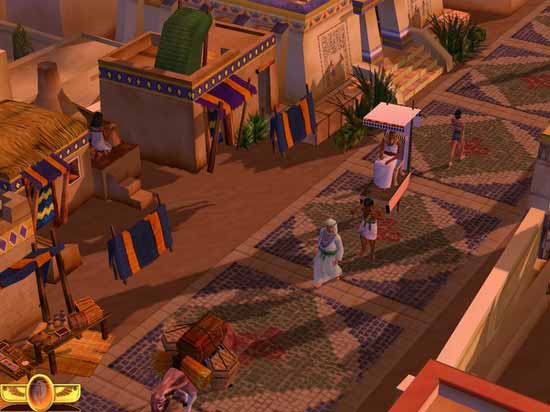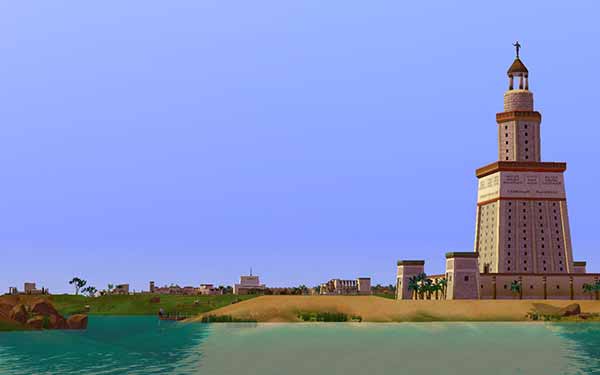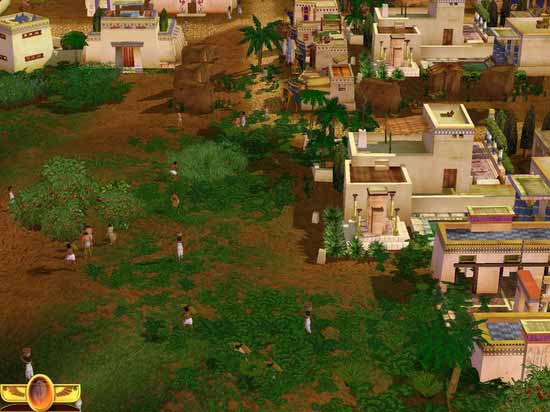Children of the Nile is a continuation, and possibly the final installment of the fairly successful Pharaoh series, taking advantage of the excellent setting of ancient Egypt as a basis for a robust city builder. The people of ancient Egypt are civilized enough to be needy bastards– a prerequisite for any builder, and in an era filled with war and great deeds, we’re off to the races of conquest and glory.
COTN’s greatest strength, without a doubt, is the ecosystem of its city. Your people have multiple “tiers” of social standing, with each level having its own behavior and needs. Your job, of course, is to keep those needs satisfied so their efforts can be directed towards doing useful things for you: killing your enemies and building great works in your name.

There are two backbones of the COTN experience: food, which serves as universal currency in a barter system, and the satisfaction of needs. Food is harvested by farmers, of course, and then wends its way through a variety of nobles (through taxes) and shopkeeps (for purchase of common and luxury goods, keys to happiness for your people). The game is actually shockingly deep in the way its economy works: for example, foreign traders might buy your cities’ products (with you taking a tariff) while selling rare goods available nowhere else.
Of course, if eating and shopping were all people needed (like in America), this game would be too easy. This being ancient Egypt, people need to pray to eleven different gods, have their dead mummified, seek healthcare, entertainment, and god knows what else. COTN makes satisfying these needs much simpler than in past installments, in that people will actively seek out their need satisfaction: for example, if they need to worship, they find a temple. If they can’t find the best solution to their need, they’ll try for a next best: i.e., a different god to worship or an herbalist instead of a hospital. This means that people are generally fairly happy with their lives and try hard to stay that way. They do have a tendency to be very brittle in going from “happy” to “ragingly pissed off and leaving” if two or three needs are unmet in rapid succession, which can be frustrating when it occurs.
The resource system is where COTN truly shines. There are a variety of resources that range from common to more expensive and rare that are used in a variety of places throughout the game, both for need satisfaction and the building of monuments and great works. For example, a luxury craftsman who is a sculptor might gather cheap clay to make statues that will mildly please the nobility, or he might get his hands on basalt or bronze to make something truly valuable. However, the same basalt could also be utilized in a religious temple or a statue that raises your prestige, so ensuring a good flow of resources is critical to keeping people happy while also furthering your empire.
As is to be expected, you rarely have all of the resources you want on the map, so the bulk of your interactions are acquired by trade with other cities. COTN features a robust world map where you can interact with other cities dispatch envoys and begin trade routes that will secure precious resources for a variety of efforts, or wage war on unfriendly cites. In other scenarios, you can dispatch massive resources to build achievements, like the Sphinx to Ra, as optional sub-objectives. The interactions with the rest of the world are very well done, and add excellent depth and challenge to the maps. Often a map will give you access to a resource both locally and via trade, so you can customize your experience accordingly.

As with many city builders, at times the game tries to do too much or is painfully lacking in certain aspects. One of the biggest flaws, as with every Pharaoh game, is combat. Periodically, in an attempt to add an extra degree of challenge, you’ll be beset by raiders. This will be 3-4 guys who run around your city stealing anything they can, until they are intercepted by city guards and killed. However, city guards will usually (there are minor exceptions that don’t really make sense) only patrol at user built guard posts, and only in a limited radius.
If raiders are present in the city, unless they cross the patrol path, the guards are agonizingly slow to react. Further, the raider AI tends to prefer running around stealing as opposed to fighting, so there is often a Benny Hill-esque scenario where the raiders are running around stealing while your (fortunately slightly faster) guards chase them down to fight and kill them. Unsurprisingly, the game only supports 1v1 combat, so excess guards have to wait for their friends to die before they join in. And if a guard isn’t fighting, they will do whatever they feel like, such as going for a snack or going home while their comrades fight and die. I suspect the guards have a very good union.
Finally the game’s “monuments,” a staple of an Egyptian game, seem to be very half-assed and reek of deadline time cutting. There are surprisingly few monuments that can be built, the majority of which are the same thing in a variety of sizes (i.e. very small through ginourmous pyramids). There are a smattering of religious statues, but they are more limited in selection than the relevant gods in the game, indicating to me they ran out of time to develop art assets for all of the gods. I was hoping this would be resolved or enriched in the Alexandria expansion, but the expansion only adds “Great Works,” i.e. the Great Lighthouse and Library of Alexandria.
These Great Works require a greater variety of resources to build, i.e. wood, copper, and jewels in addition to just limestone and bricks, which is a good thing, but points out a lack of such variety in the core game. Pyramid and mastaba construction would be more interesting if one were required to add various resources to entomb the Pharaoh with, as per history. As it stands, you can just spam these buildings if you have the requisite bricks and limestone, decreasing their grandeur. There are a few other frustrating nitpicks: the game stretches on a bit too long when building the largest pyramids, and there are some significant terrain issues around the Nile when building docks and the like. They’re minor, but will drive you nuts when you play.

Despite the flaws, COTN is a very solid city builder. The greatest strength is that it simply is a compelling game to play; each scenario is varied enough in terms of world politics and terrain to keep things interesting. Like many city builders, things can get repetitive; your people’s needs are static enough that the start of every game is about the same, which is a bit annoying. The base game provides solid play and replay value, with five eras to play through and three maps for each era, with varying goals for each, for a total of 15 different scenarios. The Alexandria expansion adds several more eras focused on that city’s exploits. On the whole, COTN and the Alexandria expansion are a great buy for any city builder lover looking to occupy ten or twenty hours of lording over a bunch of cat worshippers, leading them to glory and (limited) monument building.


Solid review–this is probably my all-time favorite city-builder.
It looks amazing but lacks dinosaurs. Is there a dinosaur patch?